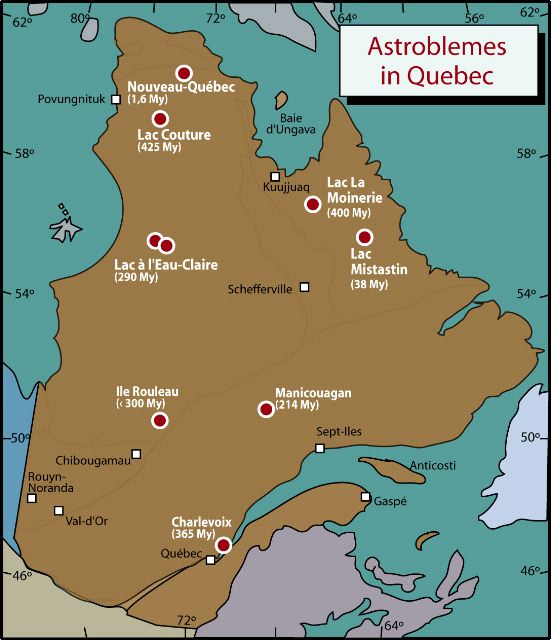The Late Devonian extinction event
Towards the end of the Devonian, at the boundary between the Frasnian and Famennian ages (about 375 million years ago), a great extinction turned the living world upside-down.
 (56 kb) It was the second mass extinction to hit the planet, the first being at the end of the Ordovician. This time, it was not a single, abrupt event, but instead a series of extinctions spread out over a relatively short period of two to four million years.
(56 kb) It was the second mass extinction to hit the planet, the first being at the end of the Ordovician. This time, it was not a single, abrupt event, but instead a series of extinctions spread out over a relatively short period of two to four million years.
At that time, the colonization of land by terrestrial plants, invertebrates and the first tetrapods was still in its early days. Animal groups already adapted to land were less affected by the crisis because paleontologists find their populations “intact” in the Carboniferous Period that immediately followed. Marine species, on the other hand, were very hard hit.
Large underwater reef ecosystems, constructed mainly by rugose and tabulate corals and by stromatoporoids, dramatically vanished. They would not return until 145 million years later in the Triassic Period, built that time by scleractinian corals and calcisponges.
It is estimated that 75% of all fish families disappeared during this Upper Devonian extinction. Although freshwater fish were barely affected, marine animals were much more so. Placoderms, for example, did not survive, acanthodians were decimated, and almost all agnathans vanished. Numerous brachiopods became extinct, conodonts all but disappeared, and only one family of trilobites survived. In total, over 70% of species living in the Devonian no longer existed in the Carboniferous Period.
Marine hypoxia? Global cooling? A drop in sea level? Meteorites? Many hypotheses have been advanced to explain the Devonian mass extinction. The cause remains poorly understood, and perhaps the difficulty lies in that there were multiple causes! But whatever the reason, as is always the case following major extinctions, life reorganized itself within the oceans, and tetrapods and plants continued their conquest of the land.
The plants and animals represented by Miguasha’s fossils lived a few million years before this crisis. They therefore offer us a glimpse of life on Earth immediately before these events, particularly with respect to vertebrate diversity.

 (56 kb) It was the second mass extinction to hit the planet, the first being at the end of the Ordovician. This time, it was not a single, abrupt event, but instead a series of extinctions spread out over a relatively short period of two to four million years.
(56 kb) It was the second mass extinction to hit the planet, the first being at the end of the Ordovician. This time, it was not a single, abrupt event, but instead a series of extinctions spread out over a relatively short period of two to four million years.At that time, the colonization of land by terrestrial plants, invertebrates and the first tetrapods was still in its early days. Animal groups already adapted to land were less affected by the crisis because paleontologists find their populations “intact” in the Carboniferous Period that immediately followed. Marine species, on the other hand, were very hard hit.
Large underwater reef ecosystems, constructed mainly by rugose and tabulate corals and by stromatoporoids, dramatically vanished. They would not return until 145 million years later in the Triassic Period, built that time by scleractinian corals and calcisponges.
It is estimated that 75% of all fish families disappeared during this Upper Devonian extinction. Although freshwater fish were barely affected, marine animals were much more so. Placoderms, for example, did not survive, acanthodians were decimated, and almost all agnathans vanished. Numerous brachiopods became extinct, conodonts all but disappeared, and only one family of trilobites survived. In total, over 70% of species living in the Devonian no longer existed in the Carboniferous Period.
Marine hypoxia? Global cooling? A drop in sea level? Meteorites? Many hypotheses have been advanced to explain the Devonian mass extinction. The cause remains poorly understood, and perhaps the difficulty lies in that there were multiple causes! But whatever the reason, as is always the case following major extinctions, life reorganized itself within the oceans, and tetrapods and plants continued their conquest of the land.
The plants and animals represented by Miguasha’s fossils lived a few million years before this crisis. They therefore offer us a glimpse of life on Earth immediately before these events, particularly with respect to vertebrate diversity.
Site map | Feedback | Links | Sources | Credits
The Late Devonian extinction event
<< Life in crisis | The plant world >>

Title: Location of meteorite or fossil craters in Québec.
Author: François Bienvenue
Sources: Parc national de Miguasha
Year: 2007
Description:
The impact of bolides is often suggested to explain certain events leading up to the sudden disappearance of a large proportion of living species in Earth’s history. The meteorite crater in Charlevoix dates back to the Upper Devonian, but it is unlikely that the mass extinction at the end of the Devonian is linked to the impact of this meteorite.


